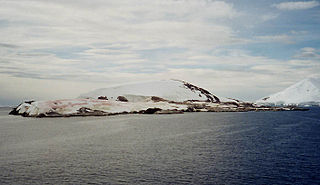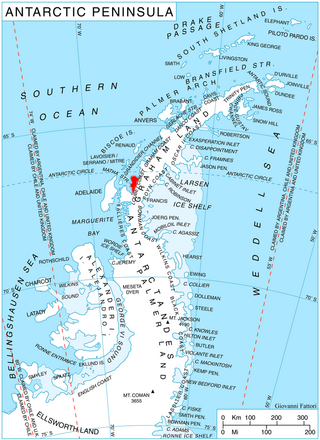Related Research Articles

Mount Terror is a large shield volcano that forms the eastern part of Ross Island, Antarctica. It has numerous cinder cones and domes on the flanks of the shield and is mostly under snow and ice. It is the second largest of the four volcanoes that make up Ross Island and is somewhat overshadowed by its neighbour, Mount Erebus, 30 km (19 mi) to the west. Mount Terror was named in 1841 by Sir James Clark Ross for his second ship, HMS Terror. The captain of Terror was Francis Crozier, a close friend of Ross for whom the nearby Cape Crozier is named.
Alexander Island, which is also known as Alexander I Island, Alexander I Land, Alexander Land, Alexander I Archipelago, and Zemlja Alexandra I, is the largest island of Antarctica. It lies in the Bellingshausen Sea west of Palmer Land, Antarctic Peninsula from which it is separated by Marguerite Bay and George VI Sound. The George VI Ice Shelf entirely fills George VI Sound and connects Alexander Island to Palmer Land. The island partly surrounds Wilkins Sound, which lies to its west. Alexander Island is about 390 kilometres (240 mi) long in a north–south direction, 80 kilometres (50 mi) wide in the north, and 240 kilometres (150 mi) wide in the south. Alexander Island is the second-largest uninhabited island in the world, after Devon Island.

Petermann Island is a small, low and rounded island, lying off the northwest coast of Kyiv Peninsula in Graham Land, Antarctica, a short distance south of Booth Island and the Lemaire Channel. It is a popular tourist destination.


Arrowsmith Peninsula is a cape about 40 miles (64 km) long on the west coast of Graham Land, west of Forel Glacier, Sharp Glacier and Lallemand Fjord, and northwest of Bourgeois Fjord, with Hanusse Bay lying to the northwest. It was surveyed by the Falkland Islands Dependencies Survey (FIDS) in 1955-58 and named for Edwin Porter Arrowsmith, Governor of the Falkland Islands.
Indicator Island is an island 0.16 km (0.1 mi) long, lying 0.16 km (0.1 mi) west of the northwest end of Galindez Island in the Argentine Islands, Wilhelm Archipelago, Antarctica. It was charted and named in 1935 by the British Graham Land Expedition under John Rymill. A windsock was erected on this island by the expedition to indicate wind direction for the expedition's airplane.

Prospect Point is a headland at the west extremity of Velingrad Peninsula on Graham Coast in Graham Land, four kilometres south of Ferin Head and immediately east of the Fish Islands. Roughly charted by the British Graham Land Expedition (BGLE) under Rymill, 1934–37. Photographed by Hunting Aerosurveys Ltd. in 1956–57. The name was suggested in 1957 by E. P. Arrowsmith, Governor of the Falkland Islands.

Flask Glacier, is a gently-sloping glacier, 25 nautical miles long, flowing east from Bruce Plateau to enter Scar Inlet between Daggoo Peak and Spouter Peak in Graham Land, Antarctica. The lower reaches of this glacier were surveyed and photographed by the Falklands Islands Dependencies Survey (FIDS) in 1947. The entire glacier was photographed by the Falkland Islands and Dependencies Aerial Survey Expedition in 1955–56, and mapped by the FIDS in 1957. It was named by the UK Antarctic Place-names Committee after the third mate on the Pequod in Herman Melville's Moby-Dick; or, The White Whale.
Armstrong Reef is a reef that encompasses many ice-free plutonic islets and rocks, extending for 9 km (6 mi) from the south-west end of Renaud Island, in the Biscoe Islands of Antarctica. It was first accurately shown on an Argentine government chart of 1957, and was named by the UK Antarctic Place-Names Committee for Terence Armstrong, a British sea ice specialist.
Murtaugh Peak is a sharp peak, 3,085 m, surmounting a ridge 4 nautical miles (7 km) west-northwest of Mount Minshew in the Wisconsin Range, Horlick Mountains, Antarctica. Mapped by United States Geological Survey (USGS) from surveys and U.S. Navy air photos, 1960–64. Named by Advisory Committee on Antarctic Names (US-ACAN) for John G. Murtaugh, geologist with the Ohio State University geological party to the Horlick Mountains, 1964–65.

Mount Strybing is a mountain standing on Owen Ridge 3 nautical miles (6 km) southeast of Mount Craddock in the south part of Sentinel Range, Ellsworth Mountains. It is linked to Mount Craddock by Karnare Col, and surmounts Saltzman Glacier to the northeast, Brook Glacier to the southwest, and Severinghaus Glacier to the west-northwest.

Guerrero Glacier is a glacier about 7 nautical miles (13 km) long in Doyran Heights, draining from the southeast slopes of Mount Havener southwest of Beloslav Peak to the south side of Taylor Spur, in the southeast part of the Sentinel Range, Ellsworth Mountains, Antarctica. It was first mapped by the United States Geological Survey from surveys and U.S. Navy air photos, 1957–59, and was named by the Advisory Committee on Antarctic Names for John F. Guerrero, a meteorologist at South Pole Station in 1957.
Grotto Island is a narrow island 0.5 nautical miles (1 km) long with a serrated coastline, lying 0.1 nautical miles (0.2 km) north of Galindez Island in the Argentine Islands, Wilhelm Archipelago, Antarctica. It was charted and named in 1935 by the British Graham Land Expedition under John Rymill.
Trigonia Island is a small island immediately off the south tip of Beer Island, lying 8 nautical miles (15 km) west of Prospect Point, off the west coast of Graham Land, Antarctica. It was charted and named by the British Graham Land Expedition (BGLE), 1934–37, under Rymill.
Milnes Island is an island lying 2 nautical miles (4 km) north of Woolpack Island, in the Biscoe Islands of Antarctica. It was charted by the British Graham Land Expedition under John Rymill, 1934–37, and was named by the UK Antarctic Place-Names Committee in 1959 for Leading Seaman Arthur R. Milnes, Royal Navy, a member of the British Naval Hydrographic Survey Units in the area in 1956–57 and 1957–58.
Hermes Glacier is a glacier 8 nautical miles (15 km) long, flowing west into Weyerhaeuser Glacier in southern Graham Land, Antarctica. It was surveyed in January 1960 by the Falkland Islands Dependencies Survey who discovered the glacier after several fruitless attempts to find a route out of the mountains east of Earnshaw Glacier. It provided an ideal "road" back to known country and was therefore named after Hermes, the god of roads in Greek mythology. This name by the UK Antarctic Place-Names Committee initiated the idea of naming other features in this area after Greek gods.

McCance Glacier is the 30-km long and 5 km wide glacier draining the Hutchison Hill area on the west slopes of Avery Plateau on Loubet Coast in Graham Land, Antarctica. It flows north-northwestwards along the west side of Osikovo Ridge, Kladnitsa Peak and Rubner Peak and enters Darbel Bay.

Mapple Glacier is a narrow glacier 15 nautical miles (28 km) long, flowing eastward between Arkovna Ridge and Stevrek Ridge in the Aristotle Mountains of Antarctica to enter Sexaginta Prista Bay on the east side of Graham Land. It lies 2 nautical miles (4 km) north of Melville Glacier and is separated from it by a line of small peaks. The glacier was surveyed by the Falkland Islands Dependencies Survey in 1961, and was named by the UK Antarctic Place-Names Committee after Father Mapple, the whalemen's Nantucket priest in Herman Melville's Moby-Dick.

Hough Glacier is a glacier in central Doyran Heights in the Sentinel Range of Ellsworth Mountains, Antarctica, rising just south of Mount Tuck and flowing east-southeast for 10 nautical miles between Guerrero Glacier and Remington Glacier. It was first mapped by the United States Geological Survey from surveys and U.S. Navy air photos, 1957–59, and was named by the Advisory Committee on Antarctic Names for William S. Hough, who made ionosphere studies at South Pole Station in 1957.

Las Palmas Glacier is a glacier flowing west-northwest from Hurd Dome and terminating at Las Palmas Cove, South Bay, Livingston Island, Antarctica. The name was given by the Spanish Antarctic Expedition, about 1991, after the ship Las Palmas of the Spanish Antarctic campaigns since 1988.
References
- ↑ "Holmes Island". Geographic Names Information System . United States Geological Survey, United States Department of the Interior . Retrieved 22 June 2012.
![]() This article incorporates public domain material from "Holmes Island (Antarctica)". Geographic Names Information System . United States Geological Survey.
This article incorporates public domain material from "Holmes Island (Antarctica)". Geographic Names Information System . United States Geological Survey.
